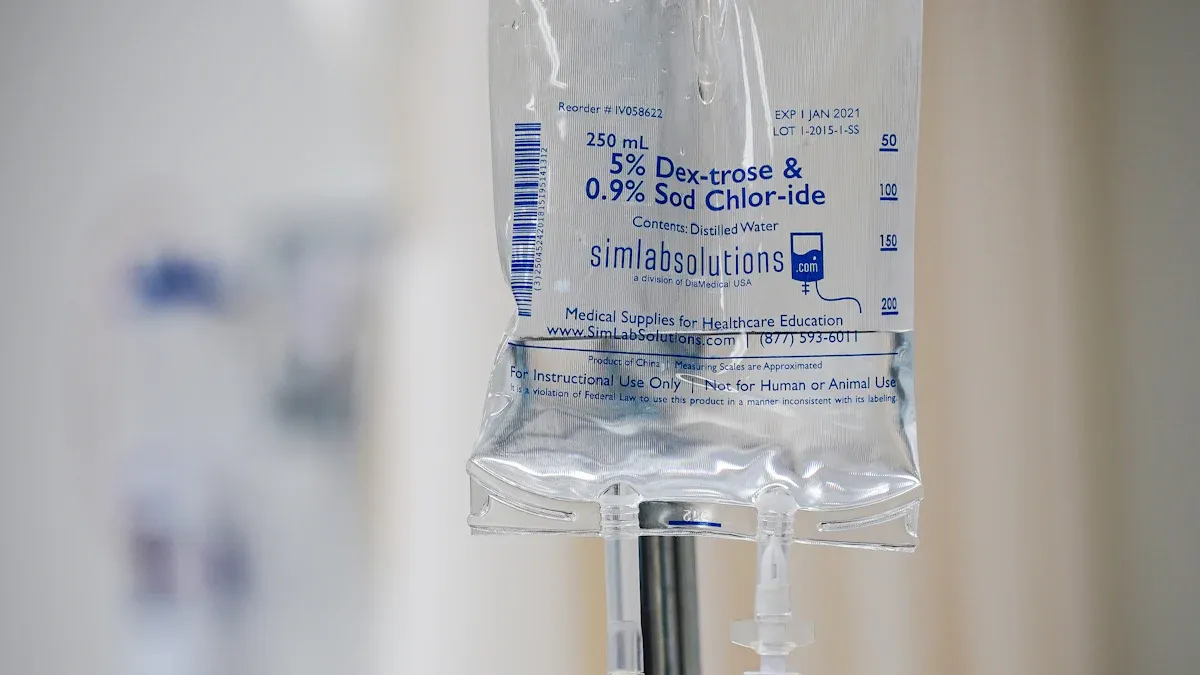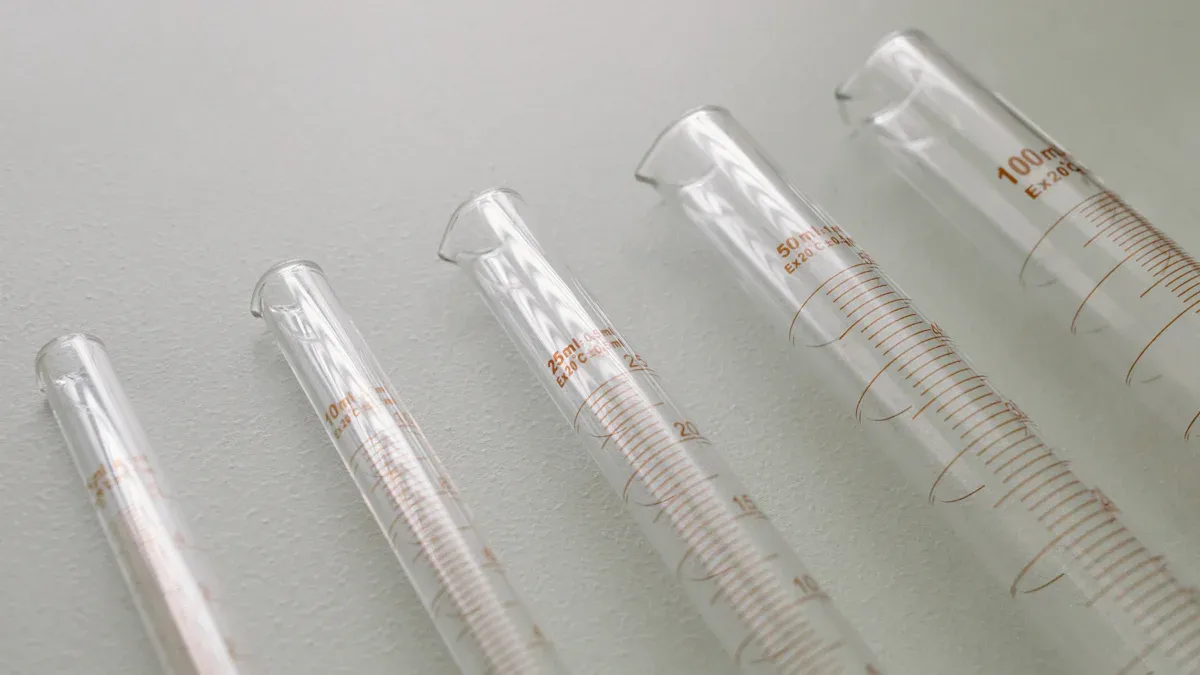Crafting Precision: PET Tubing for Medical Device Manufacturing

Polyethylene terephthalate (PET) tubing plays a critical role in the medical field, offering unmatched precision and adaptability. Manufacturers employ advanced extrusion techniques to create tubing tailored to specific medical device requirements. Customizable PET Tubing for Medical Devices allows engineers to adjust dimensions, wall thickness, and coatings, ensuring compatibility with intricate designs.
Demand for PET tubing continues to grow due to its essential role in modern healthcare.
The global medical tubing market, valued at USD 11 billion in 2023, is projected to reach USD 18.41 billion by 2030.
This growth stems from the rise of minimally invasive treatments and home healthcare, which rely on disposable tubing for devices like catheters and IV lines.
PET tubing’s biocompatibility and durability make it indispensable for nerve-related procedures. Its performance often surpasses alternatives like silicone, which, while flexible, lacks PET’s strength and chemical resistance.
Key Takeaways
PET tubing is important for medical devices because it is strong, bendable, and safe for the body. It works well for fixing nerves.
Engineers can change PET tubing sizes and add coatings to fit different medical needs.
Working with skilled makers helps create better designs and new ideas to help patients heal faster.
PET tubing lasts longer and is tougher than silicone, making it work well in hard medical situations.
The need for better tools in simple surgeries and home care is making the medical tubing market grow quickly.
The Role of Customizable PET Tubing in Medical Devices
Unique properties of PET tubing
Customizable PET tubing for medical devices offers a combination of strength, flexibility, and chemical resistance. These properties make it ideal for demanding medical applications. PET tubing exhibits exceptional mechanical properties, including high tensile strength and durability. Studies show that PET nanocomposites, such as those reinforced with CaCO3, achieve a tensile strength of 55.1 MPa and a Young’s modulus of 2.51 GPa. This enhancement results from the uniform dispersion of nanoparticles within the PET matrix. These characteristics ensure that PET tubing can withstand the stresses of medical procedures while maintaining its structural integrity.
Additionally, PET tubing resists wear and tear, making it suitable for long-term use. Its chemical resistance prevents degradation when exposed to bodily fluids or sterilization processes. These features, combined with its biocompatibility, ensure that PET tubing meets the stringent requirements of medical-grade materials.
Applications in nerve-related medical devices
PET tubing plays a vital role in nerve repair and regeneration. It is commonly used in nerve conduits, which guide the growth of peripheral nerves after injury. These conduits provide a protective environment, ensuring that regenerating nerves remain aligned and shielded from external damage. PET’s strength and flexibility allow it to mimic the natural structure of nerves, promoting effective healing.
Peripheral nerve injuries often require precise solutions. Customizable PET tubing for medical devices enables engineers to design conduits tailored to specific nerve repair needs. This customization ensures that the tubing fits seamlessly into the surgical site, enhancing patient outcomes.
Advantages over alternative materials
PET tubing offers several advantages over materials like silicone. While silicone is flexible, it lacks the tensile strength and chemical resistance of PET. Silicone conduits may degrade over time, compromising their effectiveness in nerve repair. In contrast, PET tubing maintains its structural integrity, even under challenging conditions.
The ability to customize PET tubing further enhances its appeal. Engineers can adjust dimensions, wall thickness, and surface treatments to meet specific medical requirements. This level of customization is often difficult to achieve with silicone. PET’s durability and adaptability make it the preferred choice for nerve-related medical devices and other applications requiring precision and reliability.
Medical Tubing Manufacturing Process

Plastic extrusion techniques
The medical tubing manufacturing process begins with plastic extrusion, a critical step in creating high-quality tubing. This technique involves melting thermoplastic materials, such as polyethylene terephthalate (PET), and forcing the molten material through a shaping die. The die determines the tubing's dimensions and shape.
Plastic extrusion is a high-volume manufacturing process that ensures uniformity and precision. The melted material, under controlled pressure, exits the die and takes on its final form.
Key stages in the extrusion process include:
Material Selection: Engineers choose polymers like polycarbonate, polypropylene, or polyethylene based on the tubing's intended application.
Cleanroom Environment: Manufacturing occurs in ISO-certified cleanrooms to prevent contamination, ensuring the tubing meets medical-grade standards.
Extrusion Process: Thermoplastic materials are melted and shaped through a die to achieve the desired dimensions.
Cooling System: Rapid cooling solidifies the tubing, preserving its structural integrity.
This process ensures that the tubing meets the stringent requirements of medical device tubing, including durability, flexibility, and biocompatibility.
Customization during production
Customization plays a pivotal role in the fabrication of medical tubing. Manufacturers tailor the tubing's dimensions, wall thickness, and other parameters to meet specific medical needs. PET tubing, for example, can be customized to create nerve conduits or other specialized components.
The following table highlights the technical performance data for PET tubing customization:
Parameter | Value |
|---|---|
Inner Diameter | 0.25 |
Wall Thickness | 0.005~0.200mm (0.0002''-0.008'') |
Length | ≤2100mm |
Color | Clear, Black, White, and Customized |
Shrink Ratio | 1.2:1, 1.5:1, 2:1 |
Shrink Temperature | 90°C |
Melting Point | 247±2°C (476.6±3.6°F) |
≥30000PSI | |
Biocompatibility | Meets ISO 10993 and USP Class VI |
Sterilization Method | Ethylene oxide, gamma rays, electron beam |
Environmental Protection | RoHS Compliant |
Manufacturers like Nordson Medical offer the ability to design custom tubing from prototype to full-scale production. They ensure tight tolerances and thin walls, which are essential for applications like nerve repair. Standard-sized tubing typically has a lead time of two weeks, while customized sizes may take up to four weeks.
Quality control for medical-grade tubing
Quality control is a cornerstone of the medical tubing manufacturing process. Manufacturers implement rigorous testing protocols to ensure the tubing meets the highest standards of safety and performance.
Key quality control measures include:
Dimensional Accuracy: Engineers verify that the tubing's dimensions align with the specified tolerances.
Material Testing: Tests confirm the tubing's biocompatibility, tensile strength, and resistance to wear and tear.
Sterilization Validation: Tubing undergoes sterilization using methods like ethylene oxide or gamma rays. This step ensures the tubing remains safe for medical use.
Visual Inspection: Technicians inspect the tubing for defects, such as surface irregularities or inconsistencies in wall thickness.
These measures guarantee that the tubing performs reliably in medical applications, including nerve-related procedures. By maintaining strict quality control, manufacturers uphold the integrity of plastic medical tubing and its role in modern healthcare.
Customization Options for PET Tubing
Tailoring dimensions and wall thickness
Custom fabrication of silicone tubes and PET tubing allows manufacturers to meet the precise requirements of medical devices. Engineers adjust dimensions and wall thickness to ensure compatibility with specific applications, such as nerve conduits or catheters. PET tubing offers flexibility in design, enabling the creation of custom solutions for diverse medical needs.
The ability to tailor dimensions enhances the performance of PET tubing in nerve-related procedures. For example, tubulization techniques rely on tubing with precise inner diameters and wall thicknesses to guide nerve regeneration effectively. Custom-made silicone tubes and PET tubing provide the structural integrity required for these procedures, ensuring optimal outcomes.
Manufacturers use advanced extrusion methods to achieve tight tolerances during production. These methods ensure that the tubing maintains consistent dimensions, even in complex designs. Engineers also consider factors like shrink ratios and melting points to create tubing that withstands sterilization and clinical use of silicone conduits.
Surface treatments and coatings
Surface treatments and coatings enhance the functionality of PET tubing, making it suitable for demanding medical applications. These treatments improve properties like antimicrobial resistance, adhesion strength, and durability.
Antimicrobial coatings prevent bacterial growth, ensuring the tubing remains safe for clinical use. Tests conducted on PET films demonstrated their effectiveness against E. Coli CECT 434, highlighting their potential in medical environments.
Adhesion strength, evaluated through delamination tests, ensures that coatings remain intact during repeated use. This robustness is critical for applications requiring long-term reliability.
Surface treatments also play a vital role in fabricating custom-made silicone tubes and PET tubing. They improve the tubing's compatibility with medical devices, enhancing its performance in nerve-related procedures. For example, coatings can reduce friction, allowing the tubing to integrate seamlessly with other components.
Integration with medical device components
Integration with medical device components improves the overall performance of PET tubing. Manufacturers design tubing to work in harmony with devices like catheters, nerve conduits, and surgical instruments. This integration ensures that the tubing meets the specific needs of medical applications.
Feature | Benefit |
|---|---|
High-temperature sterilization | Ensures durability during repeated use, critical for medical applications. |
Advanced formulations | Enhances cyclic fatigue resistance by 40%, making it suitable for demanding environments. |
Compliance with ISO standards | Retains elongation-at-break rates above 80% after sterilization, ensuring reliability. |
Custom fabrication of silicone tubes and PET tubing enables engineers to create components tailored to specific medical devices. For example, nerve conduits require tubing with precise dimensions and coatings to guide nerve regeneration effectively. This customization ensures that the tubing integrates seamlessly into the surgical site, enhancing patient outcomes.
Manufacturers prioritize compatibility during the design process, ensuring that PET tubing aligns with the tubulization concept used in nerve repair. This approach guarantees that the tubing performs reliably in clinical settings, even under challenging conditions.
Benefits of PET Tubing for Medical Applications

Biocompatibility and safety
PET tubing offers exceptional biocompatibility, making it suitable for use in medical devices. Its compatibility with human tissues ensures minimal risk of adverse reactions during procedures like peripheral nerve surgery. PET tubing meets stringent standards, including ISO 10993 and USP Class VI, which validate its safety for clinical applications. These certifications confirm that PET tubing can be used in nerve regeneration without compromising patient health.
Sterilization methods, such as gamma rays and ethylene oxide, further enhance its safety profile. PET tubing retains its structural integrity after sterilization, ensuring reliable performance in surgery. This durability under sterilization processes makes it ideal for nerve-related procedures, where maintaining sterility is critical.
Durability and wear resistance
PET tubing demonstrates superior durability and wear resistance, outperforming alternative materials like silicone. Comparative performance data highlights PET char-filled composites as highly resistant to erosive wear. Unlike cashew biochar, which shows deep grooves and extensive surface damage, PET char exhibits minimal erosion. This resilience ensures that PET tubing remains effective under challenging conditions, such as repeated use in nerve regeneration procedures.
Silicone tubing, while flexible, lacks the erosion resistance of PET. Over time, silicone conduits may degrade, compromising their effectiveness in peripheral nerve surgery. PET tubing’s ability to withstand wear and tear ensures long-term reliability, making it the preferred choice for nerve-related medical devices.
Flexibility for diverse medical uses
PET tubing combines flexibility with strength, enabling its use in a wide range of medical applications. Its adaptability allows engineers to design tubing tailored to specific procedures, such as nerve regeneration and peripheral nerve surgery. Customization options, including adjustments to dimensions and wall thickness, ensure compatibility with intricate surgical sites.
In nerve regeneration, PET tubing provides the structural support needed to guide nerve growth effectively. Its flexibility mimics the natural structure of nerves, promoting successful regeneration. PET tubing also integrates seamlessly with other medical device components, enhancing its performance in clinical settings. This versatility makes PET tubing indispensable for diverse medical uses, from nerve conduits to catheters.
Partnering with Manufacturers for Custom Solutions
Importance of collaboration in design
Collaboration between medical device engineers and PET tubing manufacturers drives innovation. Engineers rely on manufacturers to translate complex designs into functional components. This partnership ensures that tubing meets the precise requirements of nerve-related medical devices. Manufacturers like AccuPath excel in providing tailored solutions, leveraging their expertise in extrusion techniques and material science.
Effective collaboration begins with clear communication. Engineers share detailed specifications, including dimensions, wall thickness, and surface treatments. Manufacturers use this information to create tubing that integrates seamlessly into nerve conduits and other medical devices. Joint efforts also address challenges such as sterilization compatibility and biocompatibility, ensuring the tubing performs reliably in clinical settings.
Selecting the right PET tubing manufacturer
Choosing the right manufacturer is crucial for achieving high-quality medical tubing. AccuPath stands out as a leader in the industry, offering advanced customization options and rigorous quality control. Their commitment to precision ensures that PET tubing meets the stringent demands of nerve-related procedures.
Key factors to consider when selecting a manufacturer include:
Expertise: Manufacturers with extensive experience in medical-grade tubing, like AccuPath, deliver reliable solutions.
Customization Capabilities: The ability to tailor tubing dimensions and coatings ensures compatibility with intricate designs.
Quality Assurance: ISO-certified cleanrooms and stringent testing protocols guarantee the tubing's safety and performance.
AccuPath’s focus on innovation and collaboration makes them an ideal partner for medical device engineers. Their expertise in PET tubing customization supports the development of cutting-edge nerve repair technologies.
Examples of successful applications
Partnerships with manufacturers have led to groundbreaking advancements in medical devices. AccuPath’s PET tubing has been instrumental in creating nerve conduits that promote regeneration after injury. These conduits provide structural support, guiding nerve growth and improving patient outcomes.
The benefits of partnering with manufacturers are evident in the following outcomes:
Benefit/Outcome | Description |
|---|---|
Simplified Assembly | PET heat shrink tubing eliminates the need for adhesives, streamlining the assembly process. |
Cost Efficiency | Reduces material costs and minimizes production steps by eliminating adhesive curing time. |
Durability | Retains significant tensile strength after multiple sterilization cycles, ensuring reliability. |
Flexibility | Ideal for intricate designs, conforming to complex geometries in medical devices. |
Market Growth | The healthcare segment of PET tubing is projected to capture up to 20% of the market share. |
Performance Standards | Supports high-performance medical devices, ensuring functionality and integrity in delicate designs. |
AccuPath’s contributions to nerve-related medical devices highlight the importance of collaboration. Their ability to deliver durable, flexible, and biocompatible PET tubing has revolutionized nerve repair techniques. These successes underscore the value of partnering with experienced manufacturers for custom solutions.
PET tubing delivers unmatched precision and reliability for medical devices. Its unique properties, such as strength and biocompatibility, make it essential for applications like nerve repair. The ability to customize dimensions and coatings ensures compatibility with intricate designs, enhancing its role in nerve-related procedures. Collaborating with experienced manufacturers allows engineers to create innovative solutions tailored to specific medical needs. This partnership drives advancements in nerve regeneration technologies, improving patient outcomes. PET tubing continues to prove its value in modern healthcare, particularly in addressing complex nerve challenges.
FAQ
What makes PET tubing biocompatible for medical applications?
PET tubing meets stringent standards like ISO 10993 and USP Class VI. These certifications confirm its compatibility with human tissues. Its chemical stability ensures minimal risk of adverse reactions, making it safe for procedures like nerve repair and other medical uses.
How does PET tubing compare to silicone in durability?
PET tubing outperforms silicone in durability and wear resistance. It resists erosion and maintains structural integrity under challenging conditions. Silicone, while flexible, degrades over time, making PET the preferred choice for long-term medical applications.
Can PET tubing be sterilized without losing its properties?
Yes, PET tubing withstands sterilization methods like gamma rays and ethylene oxide. It retains its tensile strength and flexibility after multiple sterilization cycles, ensuring reliable performance in clinical settings.
What customization options are available for PET tubing?
Manufacturers offer options like tailored dimensions, wall thickness, and surface coatings. These customizations ensure compatibility with specific medical devices, such as nerve conduits or catheters, enhancing their functionality and performance.
Why is collaboration with manufacturers important for PET tubing design?
Collaboration ensures that PET tubing meets precise medical requirements. Manufacturers provide expertise in extrusion techniques and material science, enabling engineers to create innovative solutions for complex medical devices like nerve conduits.
See Also
Latest Innovations in Etched PTFE for Catheters
The Importance of Ultra-Thin PET Tubing in Medical Devices
Advantages of Extruded PTFE Liners in Medical Applications

